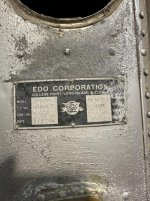jrussl
BENEFACTOR
Madison, WI
Sadly, my floats have been on the wall in my hangar since 2006. I just got them down and onto a couple of sets of horses in preparation for some float flying in way north Canada next summer. They are in need of some TLC and I have a few questions.
1. The lugs (EDO calls them eye bolts)that connect the float bodies to the rigging, along with the angles they connect to inside the float, were bedded in some sort of a putty like material. This material has stayed relatively soft for 50+ years. Any suggestions as to what this bedding material is or the modern equivalent to it? I like the fact that it didn’t impede the disassembly of the components. Not to worry, the rusty bolts made the project interesting enough.
2. The floats look like they were sloshed many times with various compounds that are now half flaking artwork inside the floats. I am going to do my best to scape off the loose stuff and vacuum out the floats. Then I plan to find the leeks with a shop vac and soap solution. I recall a post from long ago where someone suggested thinning some 3M 5200 and pulling it into the leaks with a vacuum. Can anyone elaborate some more on this technique? Or suggest a better alternative.
More on the float adventure in a future post.
Thanks in advance.
Jeff

Sent from my iPhone using SuperCub.Org mobile app
1. The lugs (EDO calls them eye bolts)that connect the float bodies to the rigging, along with the angles they connect to inside the float, were bedded in some sort of a putty like material. This material has stayed relatively soft for 50+ years. Any suggestions as to what this bedding material is or the modern equivalent to it? I like the fact that it didn’t impede the disassembly of the components. Not to worry, the rusty bolts made the project interesting enough.
2. The floats look like they were sloshed many times with various compounds that are now half flaking artwork inside the floats. I am going to do my best to scape off the loose stuff and vacuum out the floats. Then I plan to find the leeks with a shop vac and soap solution. I recall a post from long ago where someone suggested thinning some 3M 5200 and pulling it into the leaks with a vacuum. Can anyone elaborate some more on this technique? Or suggest a better alternative.
More on the float adventure in a future post.
Thanks in advance.
Jeff

Sent from my iPhone using SuperCub.Org mobile app








